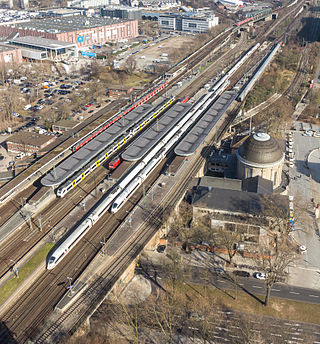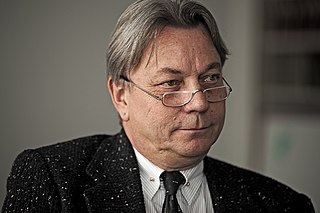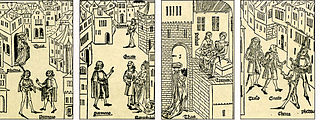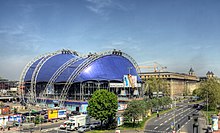
Cologne is the largest city of the German western state of North Rhine-Westphalia and the fourth-most populous city of Germany with nearly 1.1 million inhabitants in the city proper and over 3.1 million people in the Cologne Bonn urban region. Centered on the left (west) bank of the Rhine, Cologne is about 35 km (22 mi) southeast of the North Rhine-Westphalia state capital Düsseldorf and 25 km (16 mi) northwest of Bonn, the former capital of West Germany.

The Cologne–Frankfurt high-speed rail line is a 180-kilometre-long (110 mi) railway line in Germany, connecting the cities of Cologne and Frankfurt. Its route follows the Bundesautobahn 3 for the greater part, and currently the travel time is about 62 minutes. The line's grades of up to four percent require trains with a high power-to-weight ratio which is currently only met by third-generation and fourth-generation Intercity-Express trains, with the latter operating at reduced speeds. It was constructed between 1995 and 2002 at a total cost of six billion Euro according to Deutsche Bahn.

Köln Hauptbahnhof is a railway station in Cologne, Germany. The station is an important local, national and international transport hub, with many ICE, Eurostar and Intercity trains calling there, as well as regional Regional-Express, RegionalBahn and local S-Bahn trains. EuroNight and Nightjet night services also call at the station. It has frequent connections to Frankfurt by way of the Cologne–Frankfurt high-speed rail line, which starts in southern Cologne. On an average day, about 280,000 travellers frequent the station, making it the fifth busiest station in Germany.

Köln Messe/Deutz station is an important railway junction for long-distance rail and local services in the Deutz neighborhood of Cologne in the German state of North Rhine-Westphalia. It is situated close to the eastern bank of the Rhine and connected via the Hohenzollern Bridge to Köln Hauptbahnhof, the city's main station, which is just a few hundred metres away. The Cologne Trade Fair grounds are directly north of the station, hence the Messe in the station's name. The Deutz/Messe station of the Cologne Stadtbahn is nearby and connected to this station by a pedestrian tunnel.

The Cologne Stadtbahn is a light rail system in the German city of Cologne, including several surrounding cities of the Cologne Bonn Region. The term Stadtbahn denotes a system that encompasses elements of trams as well as an underground railway network (U-Bahn) and interurban rail, even including three lines that are licensed as heavy rail and used by freight trains as well as Stadtbahn vehicles. Two of these lines connect the Cologne Stadtbahn to the Bonn Stadtbahn. These lines are jointly operated by both cities' transport authorities, resulting in both systems and the lines connecting them sometimes collectively referred to as Stadtbahn Rhein-Sieg.

Cologne/Bonn Airport is a station at Cologne Bonn Airport in the German state of North Rhine-Westphalia. It was built as part of the Cologne–Frankfurt high-speed rail line and opened in June 2004 on an approximately 15 kilometre-long airport loop. It is served by Intercity-Express (ICE), Rhine-Ruhr S-Bahn and regional services.
Konrad Junghänel is a German lutenist and conductor in the field of historically informed performance, the founder and director of the vocal ensemble Cantus Cölln.
Brigitte Oelke is a Swiss singer, actress, and dancer.

The Cologne Opera is both to the main opera house in Cologne, Germany and to its resident opera company.

Köln West station is located in the northwestern edge of the Innenstadt of Cologne in the district of Neustadt-Nord in the German state of North Rhine-Westphalia. It is located on Venloer Straße (street). The station is a stop for regional services on the Cologne ring railway. It is also served by lines 3, 4 and 5 lines of the Cologne Stadtbahn, which run through the Hans-Böckler-Platz/Bf. West underground station. The surface station has two platform tracks on a 303-metre-long island platform and eight tracks without platforms, which are used by intensive freight traffic.

Theater Bonn is the municipal theatre company of Bonn, North Rhine-Westphalia, Germany. It is an organization that produces operas, musicals, ballets, plays, and concerts. It operates several performance venues throughout the town: Oper Bonn for music theatre, the Kammerspiele Bad Godesberg and Halle Beuel for plays, and the Choreographisches Theater for ballet and dance.

Schauspiel Köln is a theatre and company in Cologne, North Rhine-Westphalia, Germany. It forms together with the Cologne Opera and other houses the Bühnen der Stadt Köln. The listed building has 830 seats in the Grand House, 120 in the locksmith and 60 in the refreshment room. In addition, the listed 'Halle Kalk' has 200 seats, it was used until closing in the summer of 2015 because of the danger of collapse. Since the 2013/14 season Depot 1 and Depot 2 have been used as interim venues during the extensive renovation of the Schauspielhaus on the site of the former Carlswerk in Schanzenstraße in Cologne-Mülheim.
The following is a timeline of the history of the city of Cologne, Germany.
Thomas Krauth is a German business man, arts dealer and former musical producer.
Lucy Millowitsch was a German stage-actress, screen star, stage director/producer, theatre co-owner/manager and dramatist.

Georg Quander is a German opera and film director, music journalist, writer and culture manager. From 1991 to 2002, he was artistic director of the Deutsche Staatsoper Berlin. From 2005 to 2013, he was councillor for arts and culture of the city of Cologne. Since 2018, he has been the artistic director of the Musikkultur Rheinsberg gGmbH.
Michael Hampe was a German theatre and opera director, general manager (Intendant) and actor. He developed from acting and directing plays at German and Swiss theatres including the Bern Theatre, to focus on directing opera and managing opera houses, first at the Mannheim National Theatre, then the Cologne Opera from 1975. He was professor at the Hochschule für Musik und Tanz Köln since 1977. Hampe was influential for both the Salzburg Festival and, after the reunification of Germany, the Dresden Music Festival for which he commissioned and directed world premieres. He directed at international opera houses and festivals, including productions recorded for television, film and DVD.

The history of the theatre in Cologne, Germany, has its roots in the Middle Ages. Although there are references to the existence of a Late antiquity Cologne theatre in the Roman Colonia Claudia Ara Agrippinensium, as has also been proven for other Roman cities. Despite this culture of theatrical play cultivated in the Roman past, a direct link to this time and form does not take place until centuries later. Although Cologne was one of the most important cities in Europe in the Middle Ages, the city had no significance in the theatre sector. The indecisiveness of the mayors over the centuries marked Cologne as an exception among major German cities in the field of theatre. After the revival of this art, theatre in Cologne also underwent a change to modern history.

The Cologne Cathedral quarter is the area immediately surrounding Cologne Cathedral in Cologne, North Rhine-Westphalia, Germany. When the Gothic cathedral was built, it was closely surrounded by houses and smaller churches. When the cathedral was completed in 1880 as a national symbol, it was freed from adjacent structures and stood isolated, unhampered by traffic. After the inner city was destroyed in World War II, it was rebuilt, with a pedestrian area connecting to the cathedral. In 1970, the Domplatte was constructed as a large concrete surface without steps around the cathedral, which became the location of major open-air events such as Carnival and pop concerts. The design of the cathedral surroundings has remained a challenge for urban planning.
















